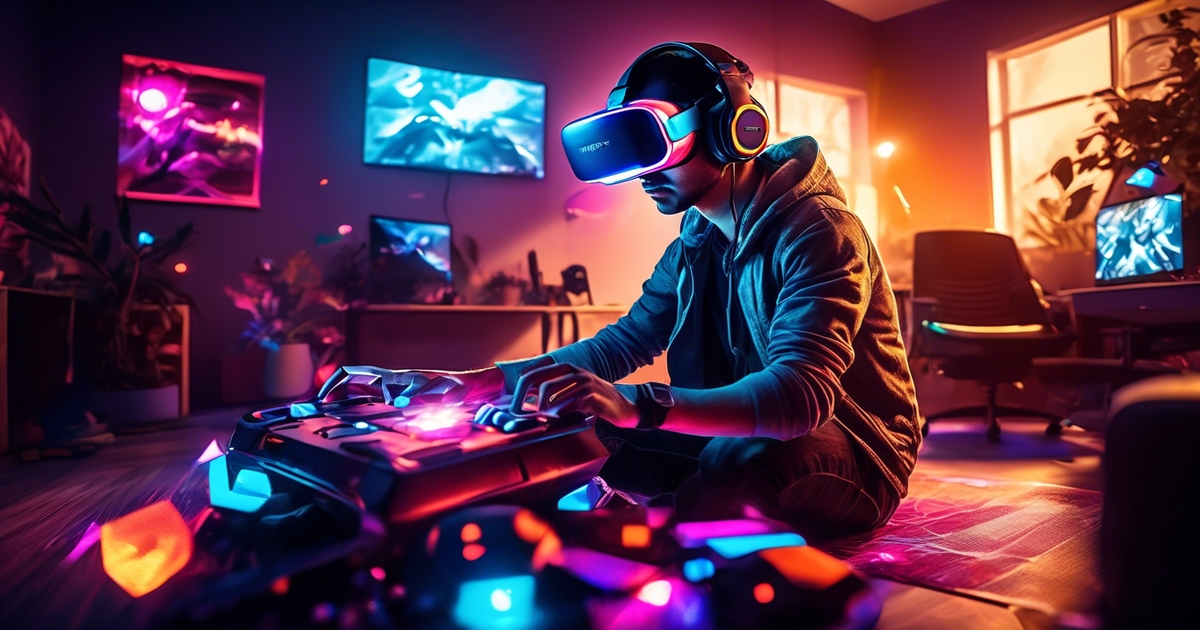How to Make a Game: Mastering Game Development Basics

- Key Takeaways
- Understanding Game Development Basics
- Researching and Conceptualizing Your Game Idea
- Creating a Compelling Game Design Document
- Choosing the Right Game Development Software
- Learning Different Programming Languages for Game Development
- Designing Characters and Graphics
- Testing, Polishing, and Exporting Your Game
- Marketing Your Game Successfully
- Exploring the World of Augmented Reality Games
- Summary
- Frequently Asked Questions
Ever wondered how to make a game that hooks players from the start? Want to create your virtual world where imagination meets innovation? Dive into the realm of game development with our expert tips and tricks.
From designing captivating storylines to mastering coding languages, we’ve got you covered.
Key Takeaways
- Understanding the basics of game development is crucial before diving into creating your own game.
- Research and conceptualize your game idea thoroughly to ensure it is unique and engaging for players.
- Create a detailed game design document to serve as a roadmap for your game development process.
- Choose the right game development software that aligns with your project requirements and skill level.
- Learning different programming languages specific to game development can enhance your ability to bring your game to life.
- Design characters and graphics that are visually appealing and resonate with your game’s theme.
Understanding Game Development Basics

Game development, also known as video game development, is the process of creating and designing interactive digital games. To embark on this exciting journey, start by understanding different game genres and platforms available in the market. By familiarizing yourself with various genres like action, adventure, or simulation games, you can gain insight into what type of game you want to create.
Next, delve into the key elements that constitute successful game development. Dive deep into gameplay mechanics – how players interact with your game – and storytelling techniques that engage and captivate your audience. Strong gameplay mechanics ensure that your game is fun to play and keeps players coming back for more. Meanwhile, mastering storytelling techniques allows you to craft compelling narratives that immerse players in your game world.
To excel in video game development, it’s crucial to grasp these fundamental concepts before diving into the actual creation process. By building a solid foundation of knowledge about different genres, platforms, gameplay mechanics, and storytelling techniques, you set yourself up for success in bringing your gaming vision to life.
Researching and Conceptualizing Your Game Idea

Researching and conceptualizing your game idea is crucial. Start by conducting market research to understand popular game trends and what your target audience prefers. This step will give you a clear idea of what games are successful in the market.
Next, brainstorm unique and innovative ideas that can set your game apart from others in the competitive gaming industry. Look for inspiration in various sources such as articles, resources, or even everyday life situations. Having a creative spark can help you develop a standout concept for your game.
Consider different factors like gameplay mechanics, art style, and storyline when fleshing out your idea. Think about the logic behind each element of the game – how they work together cohesively to create an engaging experience for players. Building on a solid basis will ensure that your final product resonates with gamers.
- Pros:
- Helps you understand current market trends.
- Encourages creativity and innovation in game development.
- Sets the foundation for a well-thought-out and appealing game concept.
- Cons:
- Requires thorough research which can be time-consuming.
- Coming up with truly unique ideas may be challenging initially.
Lastly, remember that having a clear vision of your game idea is essential before moving forward with development. By investing time into researching popular trends, brainstorming creative concepts, and considering key elements of gameplay design, you lay down a strong foundation for creating an exciting gaming experience for players.
Creating a Compelling Game Design Document

One crucial step is developing a detailed design document. This document serves as the blueprint for your game, outlining every aspect from gameplay mechanics to characters and levels. By creating a comprehensive game design document, you provide clarity on your vision and ensure all team members are aligned.
In your design document, include information about the core gameplay mechanics that will drive player engagement. Describe how players will interact with the game environment, what challenges they will face, and how they can progress through different levels or stages. Outline the characteristics of each character in the game, including their abilities, backstory, and role in advancing the storyline. Visual aids such as concept art or storyboards can further enhance understanding and bring your ideas to life for everyone involved in the project.
- Pros:
- Provides a clear roadmap for development.
- Ensures consistency in design elements throughout the game.
- Cons:
- Time-consuming to create initially.
- May require revisions as development progresses.
Choosing the Right Game Development Software
Selecting the appropriate game development software is crucial. Research various options available to you. Compare different game engines and development tools in the market.
Consider factors like ease of use, compatibility with desired platforms, and available features each software offers. Ensure that the chosen software aligns with your skill level as well as your project requirements. You want a tool that will support your vision effectively.
- Pros:
- Allows for customization based on expertise
- Offers a wide range of features to enhance gameplay
- Cons:
- Some software may have a steep learning curve
- Certain options might be limited in terms of platform compatibility
When deciding on which game development software to use, remember that each option caters to different needs. For instance, if you are new to game development, choosing user-friendly software can help you grasp concepts quickly and bring your ideas to life smoothly.
Researching popular choices such as Unity or Unreal Engine can provide insight into what seasoned game developers prefer using for their projects. Understanding how these tools work and their capabilities can guide you in making an informed decision tailored to your specific goals.
- Start by listing out your priorities: Do you value flexibility over simplicity? Are advanced graphics important?
- Test out trial versions of different softwares.
- Seek feedback from other developers or online communities.
- Consider scalability – will the chosen software accommodate future project growth?
Learning Different Programming Languages for Game Development

To make a game, it’s crucial to gain proficiency in various programming languages commonly used in game development, such as C++, Java, or Python. Understanding the fundamentals of coding logic and algorithms is essential when creating games. By mastering these concepts, developers can efficiently build and optimize their games.
Exploring resources like online tutorials or courses is beneficial for learning programming for games. Platforms like DataCamp offer interactive lessons that cater specifically to game development. These resources provide structured guidance on how to code and develop games using different programming languages.
- Pros:
- Diverse skill set with knowledge of multiple programming languages.
- Ability to create complex and engaging gameplay mechanics.
- Cons:
- Steeper learning curve when delving into multiple programming languages.
- Requires dedication and practice to become proficient in each language.
- Start by selecting a primary programming language commonly used in game development, such as C++ or Java.
- Utilize online platforms like DataCamp to access specialized courses focused on game development.
- Practice coding regularly by working on small game projects to apply the learned concepts effectively.
When diving into the world of game development, having a strong foundation in various programming languages is key. Whether you choose C++, Java, Python, or Swift, each language offers unique advantages for creating different types of games. By honing your skills through online courses and practical application, you’ll be well-equipped to bring your gaming ideas to life.
Designing Characters and Graphics

Creating captivating characters is crucial when designing a game. These characters should resonate with your target audience, capturing their attention and imagination. Pay close attention to details such as character design, animations, and visual effects to make your game visually appealing.
Utilize graphic design tools like Adobe Photoshop or Illustrator to create stunning visuals for your game. Collaborating with skilled artists can also elevate the quality of your graphics, bringing unique styles and creativity to the characters. By focusing on creating visually striking characters that fit seamlessly into the game’s world, you can enhance the overall gaming experience for players.
Consider incorporating various visual effects to add depth and excitement. Implementing dynamic animations that respond to in-game actions can make the gameplay more engaging. Integrating sound effects that complement these visual elements can further immerse players in the gaming experience. By paying attention to these graphic design aspects, you can create a visually rich environment that captivates people playing your game.
Testing, Polishing, and Exporting Your Game

After creating the characters and graphics for your game, it’s time to move on to testing. This step is crucial in ensuring that your game functions smoothly without any bugs or issues. By conducting thorough testing, you can identify any glitches that may affect the gameplay experience.
Once you’ve identified the bugs through testing, it’s essential to continuously iterate and polish your game. Incorporating user feedback is key in this stage of the development process. Pay attention to what players like or dislike about your game and make necessary adjustments to enhance their experience.
When your game is polished and refined based on user feedback, it’s time to think about how you want to share it with a wider audience. One important step is to export your game to different platforms such as PC, mobile devices, or consoles. By making your game accessible across various platforms, you can reach a broader audience and maximize its impact.
- Conduct thorough testing
- Continuously iterate based on feedback
- Export your game for wider accessibility
Exporting a mobile puzzle game allows players worldwide easy access via app stores. Testing a multiplayer online shooter helps ensure smooth gameplay without technical glitches. Polishing a role-playing adventure by refining dialogues enhances player engagement.
Marketing Your Game Successfully

To successfully market your game, you need to develop a solid marketing strategy that targets your intended audience. Utilize various platforms like social media, influencers, and game review websites to gain exposure for your product. By leveraging these channels effectively, you can reach a wider audience and attract more players to try out your game.
Creating engaging trailers, screenshots, and promotional materials is essential in capturing the interest of potential players. A well-crafted trailer showcasing the exciting gameplay can draw people in and make them curious about your game. Similarly, eye-catching screenshots highlighting different aspects of the gameplay can entice players to give it a try. Promotional materials such as posters or banners with captivating visuals can further pique the curiosity of prospective players.
- Pros:
- Increases visibility
- Attracts more players
- Enhances brand awareness
- Cons:
- Requires effort and time
- May not guarantee immediate success
When marketing your game on social media platforms like Instagram or Twitter, consider running targeted ads to reach users who might be interested in similar games. Collaborating with influencers who have a following within your target demographic can also help increase exposure for your game. Reaching out to popular gaming websites or YouTube channels for reviews can provide valuable feedback and generate buzz around your product.
Exploring the World of Augmented Reality Games

Augmented reality (AR) technology revolutionizes video games by merging virtual elements with the real world. Imagine playing a game where digital characters interact in your living room or battling aliens on your street. AR enhances gameplay experiences by blending fantasy with reality, creating an immersive and interactive adventure for players.
Developing an AR game involves utilizing specialized tools and frameworks tailored for this innovative technology. These resources assist developers in seamlessly integrating virtual objects into real-world environments, enhancing the overall gaming experience. By leveraging AR development platforms such as Unity 3D or ARKit, creators can bring their visions to life and provide gamers with unique and engaging mobile game experiences.
Creating an augmented reality game opens up a realm of possibilities for developers to craft captivating worlds that blur the lines between fiction and reality. With tools like Vuforia or Spark AR Studio, creators can design games that respond to physical surroundings, allowing players to engage with digital content in ways never seen before. The fusion of video games with augmented reality offers limitless potential for innovation and creativity within the gaming industry.
- Pros:
- Enhances gameplay experiences
- Provides unique interactive adventures
- Increases player engagement
- Cons:
- Requires specialized development skills
- Potential technical challenges during implementation
Summary
You’ve now journeyed through the essential steps of game development, from grasping the basics to exploring the realm of augmented reality games. By understanding game development fundamentals, researching your ideas, crafting a solid game design document, selecting the right tools, mastering programming languages, designing captivating graphics, testing rigorously, and marketing strategically, you’re well-equipped to embark on your game creation adventure.
Remember, each stage is a building block in constructing your gaming masterpiece. So, roll up your sleeves, dive into the coding trenches, and let your creativity run wild in the digital universe!
Frequently Asked Questions
How important is it to understand game development basics before starting the process?
It’s crucial to grasp the fundamentals of game development as a strong foundation ensures smoother progress. Understanding concepts like coding, design principles, and software tools will help you navigate through challenges effectively.
What role does a compelling game design document play in the development process?
A well-crafted game design document serves as a blueprint for your project, outlining gameplay mechanics, storylines, and visual elements. It acts as a roadmap that keeps your team aligned and focused on achieving the desired outcome.
Is it necessary to learn multiple programming languages for game development?
While proficiency in one programming language is essential, having knowledge of various languages can be advantageous. Different languages cater to specific aspects of game creation such as graphics rendering or artificial intelligence, enhancing your versatility in tackling diverse tasks.
How can I effectively market my game once it’s ready for release?
Marketing plays a vital role in reaching your target audience and maximizing exposure for your game. Utilize social media platforms, influencers, press releases, and community engagement strategies to create buzz around your creation and attract players.
Why should developers consider exploring augmented reality games?
Augmented reality (AR) games offer an immersive gaming experience by blending virtual elements with real-world environments. By leveraging AR technology, developers can engage players in innovative ways while tapping into a growing market interested in interactive and experiential gameplay.
